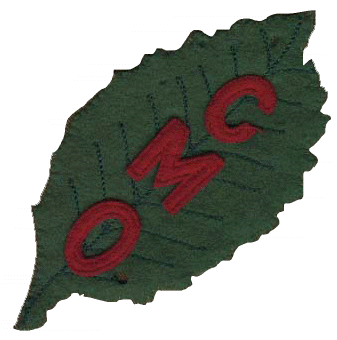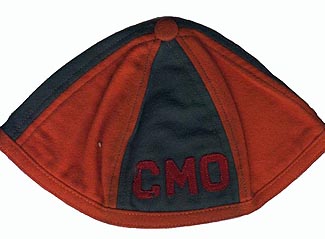Become A Sponsor
|
Why Ads


CMO Patch - Worn on Sash

Pledge Beanie
Clan of the Mystic Oak (CMO) - The Clan of the Mystic Oak (CMO) was an
honor camper organization that existed prior to the formation of Amangamek Wipit
Lodge 470. Its purpose was threefold: To further Scouting, advance the interests
of Camp Roosevelt, and to promote fellowship among its members. These goals were
identical with Dr. Goodman's goals in creating the Order of the Arrow at Treasure
Island Scout Camp: To recognize the best Scout campers and continue the traditions
and ideals of camp from season to season.
The CMO was founded at Camp Roosevelt (NCAC summer camp) on the Chesapeake Bay,
about 1921.
The scout council at that time was named the Washington D.C. Council, BSA. This
was the name it was given on June 21, 1911, when the organizational meeting of the
Council was held in the Willard Hotel. In 1919 the Washington D.C. Council acquired
Camp Roosevelt. The camp was previously named Camp Archibald Butt and was shared
by both Washington and Baltimore Councils as their summer camp in 1914 and 1915.
The camp was not used between 1916 and 1918 because of World War I.
Much like the Order of the Arrow, the CMO had three honors -- First, Second,
and Third Degree. However, an all-adult governing body called the Council of Sachems
that ran the organization.
To be eligible for initiation as a First Degree Member, a Scout had to:
- Be a First Class Scout
- Be at least a second year camper. Attendance at any Council camp was recognized
but at least two weeks had to be spent at Camp Roosevelt. Camp in those days
lasted two weeks for each session.
- Perform satisfactory service in at least four of the camp program areas.
These had to be approved by the program heads.
- Perform a special service project for Camp Roosevelt.
- Have passed a Board of Review for two Eagle-required merit badges, four
non-required.
- Be recommended by a majority of the CMO members in his Provisional Camp
Unit or the CMO members of the camp staff.
Camp Roosevelt operated with Provisional Camp Units, which were slightly larger
than a Troop. Troops seldom came together as a unit at summer camp. Each Provisional
Unit was called a Ranch and the Ranches were named after Teddy Roosevelt-related
places: Chimney Butte, San Juan, Elk Horn, Powder River, Buckskin, Big Horn, etc.
The election of the First-Degree candidates was made on the first Wednesday of
each two-week session.
The initiation ceremony started the following Saturday morning when all candidates
were called out at breakfast. The candidates were taken up behind the camp recreation
hall. Each candidate had a holly leaf placed in his mouth to remind him to keep
silent: He then received a lecture from one of the Sachems (adults). The lecture
included an admonition to keep strict silence for 24 hours (until the Sunday breakfast
ceremony). The candidate was then given a large Chestnut Gale leaf to wear that
day; the holly leaf was taken away. The candidate took part in all daily camp activities
but maintained silence. He ate a normal lunch but had no more food until Sunday
breakfast. At supper, he had to sit at his table but could not eat or speak.
After supper, guides called "Scokamules" led the candidates, with their bedrolls,
to a holding area on the trail to the CMO ceremonial grounds. Small groups were
taken to the ceremonial grounds and put through a ceremony, which included Spirits
of Earth, Woods, Fire, and Air. Each had an appropriate costume and a lesson to
teach.
After the ceremonies, the candidates were grouped around a fire and instructed
to keep it burning all night. In the morning each candidate was tempted with fresh
fruit. Then from a limb of a large hollow tree, the head Sachem administered the
final oath. The candidates were then recognized at breakfast and were given the
symbols of their membership.
To be eligible for initiation as a Second Degree Member, a Scout had to:
- Be at least a third year camper with at least four weeks of service at Camp
Roosevelt.
- Have to do or participate in a project of advanced service for Camp Roosevelt.
The project had to be approved by three Third Degree Members or Sachems.
- Have to be elected by a majority of the Second Degree Members present at
the election.
Second Degree, elections were held whenever needed.
The initiation into the Second Degree included the candidate establishing his
own camp and living in it for a day in silence and having nothing but water. It
was a day of reflection. There was a ceremony at night. After the ceremony, each
candidate was assigned a place to sleep in the woods and was left alone. The next
morning he had to find his way back. They were recognized at breakfast and given
the symbols of their membership.
Third Degree membership was honorary and elective. Second Degree members whose
record in their troops, their camp units and elsewhere was of "outstanding excellence,"
would become eligible for nomination by the Council of Sachems and election by the
CMO. During a camp session or at the first meeting after camp, any CMO member could
submit a list of the names he proposed for this honor to any member of the Council
of Sachems. The Council of Sachems would select ten names from all of the submissions
at the second meeting following camp. From this list of ten, the CMO members voted
and were allowed to select five members (adults and boys) per year to receive the
Third Degree.
The Council of Sachems elected to itself, at any regular meeting after camp,
suitable adult members who had shown conspicuous interest in the CMO and in Camp
Roosevelt.
The Council of Sachems:
- Supervised all initiation ceremonies, rituals, and qualification tests.
- Were the sole authority for determining and administering discipline, including
expelling members.
- Cooperated with youth CMO officers to the fullest extent possible while
still insuring that the purpose and traditions of the CMO were followed.
- Controlled all finances.
- Selected the ten candidates for the Third Degree each fall.
- Proposed for election each fall, the officers of the CMO.
Each September the Council of Sachems elected the President, Vice-President,
Secretary, and Treasurer.
The CMO permitted Adult Honorary Memberships. The CMO or the Council of Sachems
elected these at any regular meeting. The recognition was for outstanding service
to the CMO or to Camp Roosevelt.
Third Degree members and the officers of the CMO were allowed to attend all regular
meetings of the Council of Sachems but they were not allowed to vote.
The youth officers of the CMO were a President, Vice President, and Secretary.
They all had to be Second or Third Degree members who were not yet 21 at the time
of their election. Any member of the CMO could recommend a candidate for office.
The Council of Sachems then selected six names as nominees which they presented
at the second meeting following camp. The CMO members then selected the three officers
from the list of six.
During World War II, the CMO became less active since so many of the Sachems
and Third Degrees were off in the military service. Following the war, the CMO ceased
to operate and the only thing that was left was a few Sachems. Without new boy members
being inducted, the organization had no way to sustain itself.
On September 24, 1952, five of the remaining 19 active members of the Council
of Sachems met at the Council (BSA) Headquarters. In attendance were Thomas King--President,
Roy Swab--Secretary, John Cole--Treasurer, Ralph Bartley, Richard Ellinger, and
a professional scouter--Andrew J. Murphy. (Mr. Murphy became the first Staff Adviser
of Amangamek-Wipit Lodge and served in his Job through 1956.) At the meeting, Richard
P. Ellinger was elected as the last member to be added to the Council of Sachems.
The purpose of the meeting was to adopt a resolution to dissolve the Clan of
the Mystic Oak and clear the way for the formation of a new lodge of the Order of
the Arrow in National Capital Area Council, BSA. The existing CMO records were en-trusted
to Roy Swab for posterity. The remaining CMO funds of $107.45 were given to the
Council to purchase a memorial in the name of the CMO to Dr. Walter H. Merrill,
the Camp Roosevelt doctor, and whatever was left over was to be used for the betterment
of Camp Roosevelt. The resolution which was unanimously approved and signed by Thomas
A. King--President, Daniel J. Tyrrell--Vice President, Roy C. Swab--Secretary, and
John S. Cole--Treasurer, pledged cooperation in the future of the new Lodge of the
Order of the Arrow and permitted the new Lodge, if it so desired, to use the name
"Clan of the Mystic Oak."
Emblems of the Clan of the Mystic Oak
The badge of the CMO was a Chestnut Oak Leaf with the letters CMO superimposed.
Third Degree members could wear a badge made with a silver pin with green letters.
All other members could wear a badge made with a gold pin with green letters. Each
member could also wear a green felt patch on the right pocket of the Scout shirt.
It was in the shape of an Oak Leaf. The color of the letters "CMO" on the patch
denoted the CMO rank. Each member could also wear a beanie skullcap. The same was
true of the letters "CMO" on the cap denoted the CMO rank.
Patches
Green Felt Chestnut Oak Leaf patch with felt letters CMO was 5 1/2 inches long
and 2 ¾ inches wide and it was worn diagonally on the right pocket with the top
of the leaf pointing over the right shoulder.
- Red "CMO" Letters for First Degree,
- White "CMO" Letters for Second Degree
- Blue "CMO" letters for Third Degree
- Gold "CMO" letters for Sachems.
Hats
Beanie with Six Alternating Panels of Green and Gold with felt CMO sewed to one
of the green panels.
- Red "CMO" Letters for First Degree,
- White "CMO" Letters for Second Degree
- Blue "CMO" letters for Third Degree
- Gold "CMO" letters for Sachems.
Information was provided by Ken Finch. Scans provided by Jeff Feldman
Information originally authored by Thomas E. Reddin
****************************************
Based on information from Apatukwe OA lodge 107 history, the CMO also existed
in the Salem-Gloucester Council from 1928-1949 until it was replaced by the Unilachtego
OA Lodge 411. Their camp was also called Camp Roosevelt which has led to a bit of
confusion as to where CMO existed. I have verified with Bob Sherman that Salem-Gloucester
Council did have a Camp Roosevelt. Candidates at this location were called out on
friday nights and spent the night camping under the stars. The program worked well
and was dissolved grudgingly. It appears that the beanie that is pictured with this
page is from this location as the colors are different from what is mentioned as
having existed at the Washington Council location. -Dave Eby
Material found on this page is the work of David L. Eby and used by the USSSP,
Inc. by permission. This material may not be reproduced without the express permission
of David L. Eby
|





